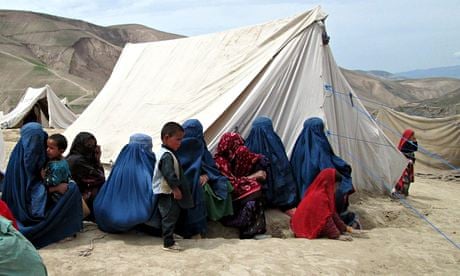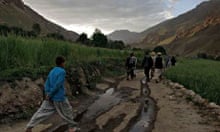Lailema's soft wailing filters through the canvas of her tent, a 12-year-old's hopeless lament for her mother and a life that is gone forever. Her three younger siblings play on the dusty floor as her grandmother cries silently nearby and her uncle wonders how to feed his new dependents.
None of them have eaten since the landslide in the village of Aab Barik – in the north-eastern province of Badakshan – that took away their home and six relatives two days earlier, despite trucks full of food aid parked just a few metres away. No one has distributed the bags of rice, oil and other necessities, they say.
"They promised that they would hand them out after the government officials leave today," said Khan Baay, the uncle, who was heading out to hear the vice-president, Yunus Qanuni, lead prayers for the dead and promise survivors whatever help they need, backed by a delegation of ministers, members of parliament and European ambassadors.
But many on the ground were less interested in pledges from dignitaries helicoptered in to survey the damage than getting their hands on something edible. "I am so hungry I could scratch your eyes out," said Bibi Jaahan, a grandmother in her early 60s who lost her home and several relatives to the mud. "I haven't eaten for over two days."
Sharing her tent is Zaina, breastfeeding her 11-month-old son but worried that her milk is drying up, as he grumbles then starts crying. She has only scavenged a few biscuits to feed him, and knows he needs more solid food.
The Afghan Red Crescent was quick to hand out tents to those who lost their homes in last Friday's devastating mudslide, and in the corner of newly motherless Lailema's cramped new home, barely two metres wide and perhaps three times as long, there are new plates and tea cups but nothing to eat off them.
They were part of their package of "non-food items", explains Ahmad, an official from the charity who stops by to check on the family. "We started handing out tents on Friday, but other organisations are responsible for food. We cannot provide everything ourselves."
The mood among mudslide survivors is mostly one of quiet frustration, anger perhaps blunted by the scale of their grief. Despite hunger most are focused on recovering the bodies of their dead, even though the government has declared the site a mass grave and ruled out further searches.
They also live in fear of further catastrophe. Cracks along the hill above where the landslide began suggest more soil could break away, and water from streams dammed by the mud is rising rapidly, in cloudy blue swirls above the buried bodies and lost buildings.
"Some of the surviving houses will soon be flooded, and there are other dangers from this water, as it is almost stagnant, like a dirty pond," said Fawzia Koofi, a local member of parliament who visited the landslide site two days in a row to check on progress and problems.
There are no toilets for the victims, who say they are heading out to the open hilltops when they need to relieve themselves, raising the risk of disease further.
UN staff thread between the tents marking children under five for polio vaccinations, the only visible medical teams, in part because the speed and scale of the landslide meant that there were few injuries to treat; almost everyone caught by the mud died within minutes.
Even survivors are unsure how many were entombed in their homes or beside the stream, because villagers were scattered between friends and relatives on the one day of rest in the Afghan week, strolling to prayers, at a wedding party or out herding livestock. Estimates range from a few hundred to more than 2,000, although all agree that more than 200 houses were destroyed – at issue is how many were inside.
Some families had fled up the hill after an earlier, much smaller landslide, but others came to help with rescue operations, only to be caught themselves by a second wave of mud. Many escaped only because they were away from home, working or tending livestock, and have lost many of their closest relatives.
Eighteen-year-old Afuzar raced back from Kabul to find his mother – his only surviving relative – nursing a foot injured when she leapt from her roof to escape the wave of debris. Her husband and three other children were trapped inside the house.
The pair had been transformed overnight from members of a poor but comfortable family of farmers with a six-room house, several dozen sheep, four cows and three donkeys, to destitute, grief-stricken and isolated refugees.
"What can I do? We have no house, and no money, but if I leave here to find work, my mother will be alone, I'm the only man in the family now," he said. "I keep turning over in my mind what to do, I can't decide."
The land for their home had been provided by the government a few years earlier, when they were evicted from a tented camp near the provincial capital. But they bear no resentment, even though two decades ago a smaller landslide had devastated the exact same area.
"The government did not have bad intentions when they gave use the land" Afuzar said. "This is God's will."
Additional reporting by Mokhtar Amiri.




